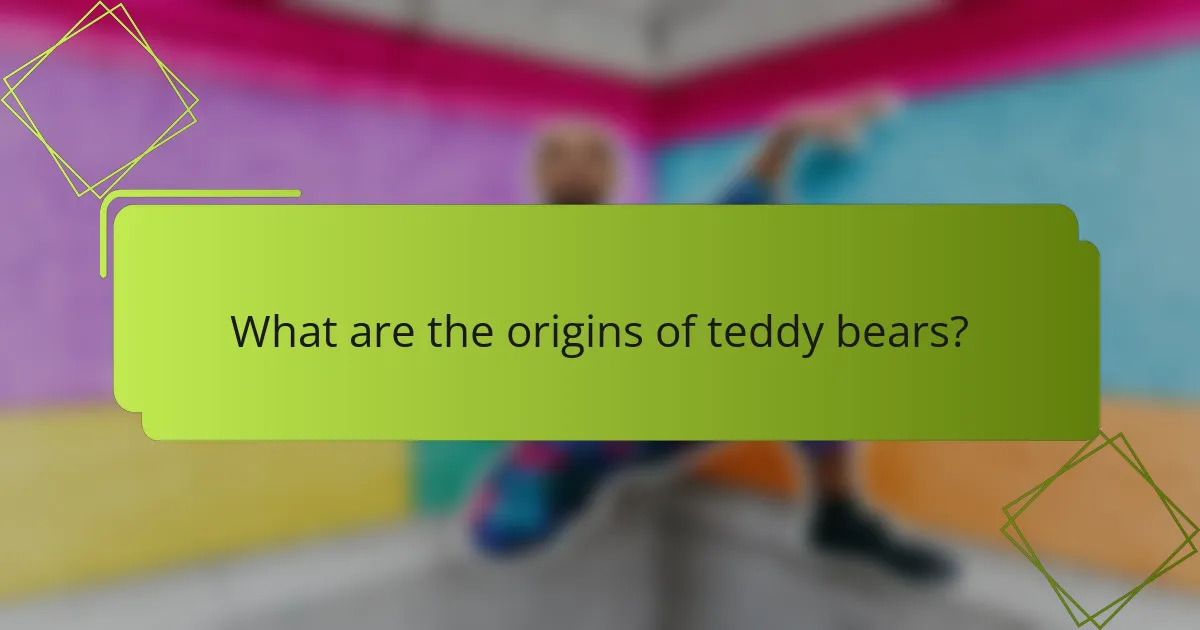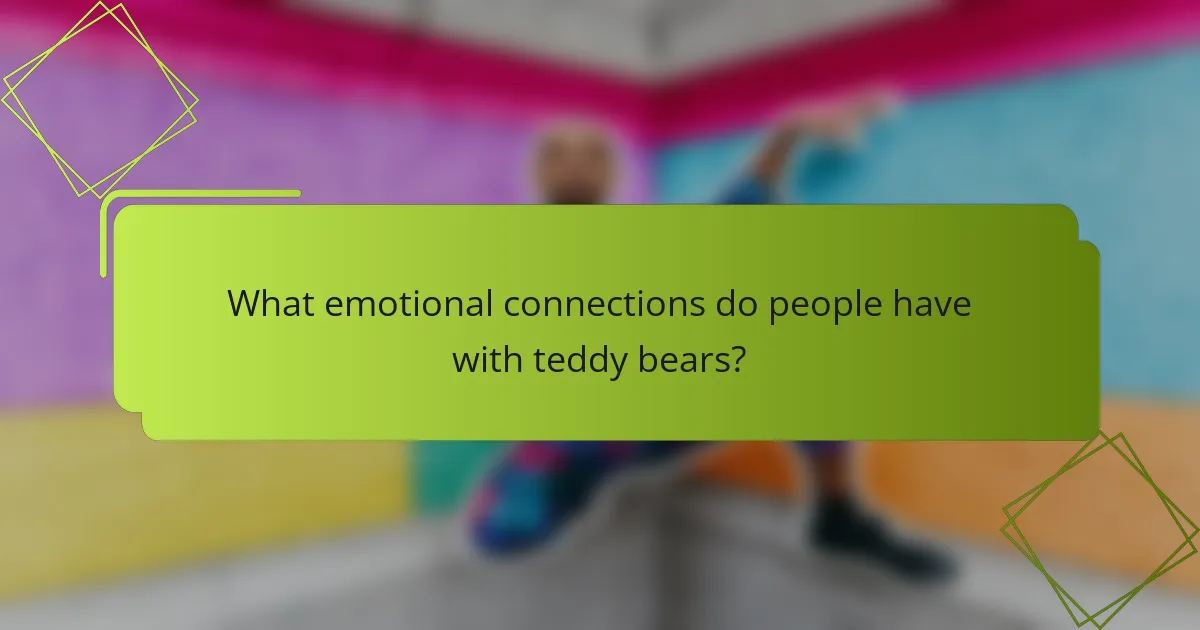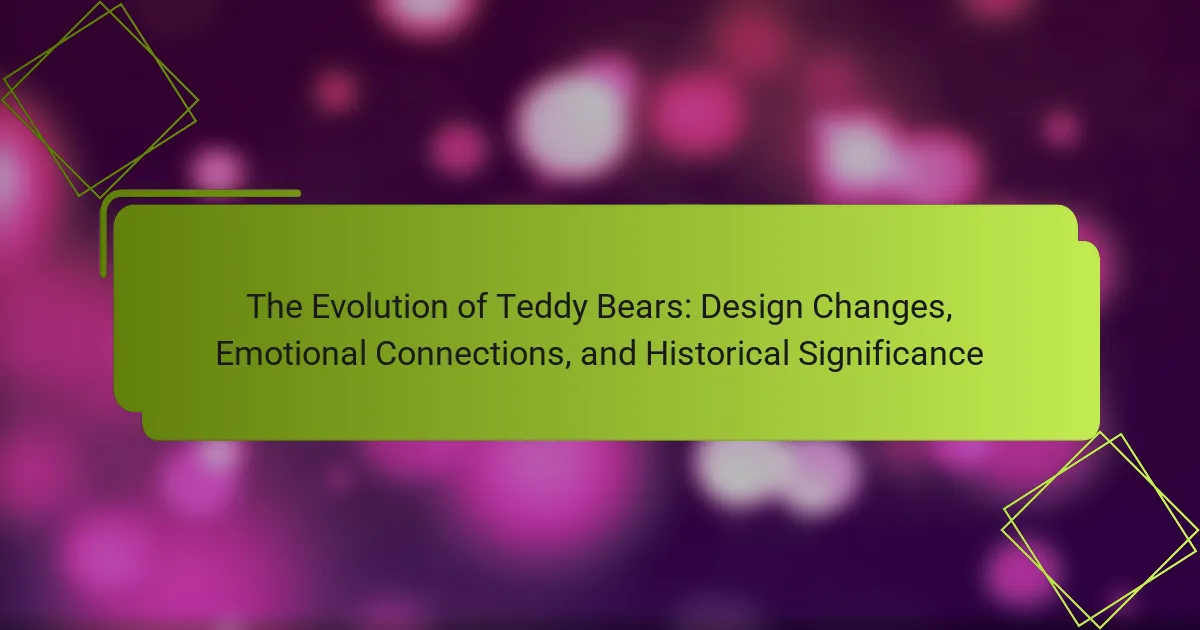
What are the origins of teddy bears?
Teddy bears originated in the early 20th century. They were inspired by a hunting trip taken by President Theodore Roosevelt in 1902. During this trip, Roosevelt refused to shoot a bear that had been captured. This incident was popularized in a political cartoon by Clifford Berryman. The cartoon led to the creation of a stuffed bear by Morris Michtom and his wife in Brooklyn, New York. They named it “Teddy’s bear” in honor of Roosevelt. The toy quickly gained popularity and became a staple for children. By 1907, teddy bears were being mass-produced and sold worldwide. This marked the beginning of their status as beloved childhood companions.
How did teddy bears become popular in the early 20th century?
Teddy bears became popular in the early 20th century due to their association with childhood innocence and comfort. The creation of the teddy bear was inspired by President Theodore Roosevelt’s bear hunting trip in 1902. Following this event, a toy maker named Morris Michtom created a stuffed bear and named it “Teddy’s bear.” This invention sparked widespread interest among children and parents alike.
In 1903, the Steiff company in Germany began producing its own version of the teddy bear. The combination of quality craftsmanship and marketing strategies led to increased sales. By the 1910s, teddy bears were featured in advertisements and became symbols of affection.
The rise of consumer culture and the establishment of department stores further contributed to their popularity. Teddy bears became widely available, making them accessible to a larger audience. The emotional connections children formed with these toys solidified their status as beloved companions.
By the end of World War I, teddy bears had become a staple in children’s toys, representing comfort during times of uncertainty. The combination of historical context, marketing, and emotional appeal solidified the teddy bear’s popularity in the early 20th century.
What historical events influenced the creation of teddy bears?
The creation of teddy bears was influenced by several historical events. The first significant event was the 1902 bear hunting trip of President Theodore Roosevelt. During this trip, Roosevelt famously refused to shoot a bear, which sparked public interest. This incident led to the creation of a stuffed bear named “Teddy’s bear.”
Another influential event was the rise of the toy industry in the early 20th century. The establishment of toy companies like Steiff in Germany facilitated mass production. Steiff’s introduction of the first commercially successful teddy bear in 1903 further popularized the toy.
World War I also played a role in the teddy bear’s evolution. Soldiers returning home often brought teddy bears as gifts for children. This practice reinforced the bear’s association with comfort and companionship.
Lastly, the Great Depression in the 1930s led to an increased demand for affordable toys. Teddy bears became symbols of comfort during tough times, solidifying their place in American culture.
Who were the key figures in the development of teddy bears?
The key figures in the development of teddy bears include Margarete Steiff, Richard Steiff, and Morris Michtom. Margarete Steiff founded the Steiff company in 1880, which produced the first commercially successful teddy bear in 1902. Richard Steiff, her nephew, designed the iconic bear with movable limbs and a distinct shape. Morris Michtom, an American, created the first teddy bear in the United States in 1902, inspired by a political cartoon of President Theodore Roosevelt. These individuals significantly influenced the teddy bear’s design and popularity, shaping it into a beloved toy worldwide.
What materials were used in the early designs of teddy bears?
Early designs of teddy bears were primarily made from mohair, felt, and cotton. Mohair, a luxurious fabric from the Angora goat, provided a soft and durable exterior. Felt was often used for [censured] features and details, giving bears a distinctive look. Cotton served as a common stuffing material, making the bears lightweight and cuddly. These materials were widely available in the early 1900s, aligning with the teddy bear’s rise in popularity. The combination of these materials contributed to the teddy bear’s iconic status in children’s toys.
How did the choice of materials impact the teddy bear’s appeal?
The choice of materials significantly enhanced the teddy bear’s appeal. Soft, plush fabrics provide a comforting touch. This tactile quality makes the teddy bear inviting for children. Additionally, high-quality materials ensure durability, leading to long-lasting companionship. The use of synthetic fibers in modern designs allows for vibrant colors and patterns. This visual appeal attracts both children and collectors. Historical materials, like mohair and felt, add a vintage charm. This connection to the past resonates with adults. Ultimately, the choice of materials contributes to emotional bonding and nostalgia.
What changes in materials occurred over the decades?
Teddy bears have undergone significant material changes over the decades. In the early 1900s, teddy bears were primarily made from mohair and felt. These materials provided a soft texture and durability. By the 1950s, manufacturers began using synthetic fibers like nylon and polyester. These materials were cheaper and easier to clean. In the 1980s, the introduction of plush fabric became popular, offering a softer feel. Today, teddy bears often use a mix of organic cotton and recycled materials. This shift reflects growing environmental awareness and consumer demand for sustainable products.

How have teddy bear designs evolved over time?
Teddy bear designs have evolved significantly since their inception in the early 20th century. Initially, teddy bears were made from mohair and featured simple, jointed limbs. Over time, materials transitioned to plush and synthetic fabrics, enhancing softness and durability. The design also shifted from realistic representations of bears to more stylized and whimsical versions.
In the 1950s, teddy bears began to incorporate colorful patterns and unique outfits, reflecting contemporary fashion trends. The introduction of safety standards in the 1980s led to designs that prioritized child safety, such as secure eyes and non-toxic materials.
Modern teddy bears often include interactive features, such as sound and motion sensors. Collectible and limited-edition bears have become popular, appealing to [censured] collectors. Overall, teddy bear designs have adapted to cultural changes, technological advancements, and consumer preferences over the decades.
What are the major design changes seen in teddy bears?
Teddy bears have undergone significant design changes over the years. Initially, they were made from mohair or felt with simple button eyes. Modern teddy bears often feature synthetic materials and safety eyes. The size and proportions of teddy bears have also evolved. Contemporary designs may include larger heads and shorter limbs for a more child-friendly appearance. Additionally, many teddy bears now incorporate sound mechanisms or interactive features. There is also a trend towards customizable designs, allowing personalization. The introduction of themed teddy bears reflects cultural trends and popular characters. These changes enhance the emotional connection children have with their teddy bears.
How have sizes and shapes of teddy bears transformed?
Teddy bears have transformed in size and shape significantly over the years. Early teddy bears, introduced in the early 20th century, were typically around 12 to 18 inches tall. These bears had a more traditional, rounded shape with shorter limbs and a distinctively large head.
In recent decades, the trend has shifted towards a wider variety of sizes. Modern teddy bears can range from tiny keychain versions to oversized plush bears that are several feet tall. The shapes have also diversified, with designs featuring elongated limbs, unique [censured] expressions, and varied proportions to cater to different aesthetic preferences and age groups.
This transformation reflects changing consumer preferences and the influence of popular culture. For instance, the rise of themed teddy bears, such as those based on movie characters, has led to more creative shapes and sizes. Additionally, advancements in manufacturing techniques have allowed for more intricate designs, including bears with jointed limbs and customizable features.
Overall, the evolution of teddy bear sizes and shapes showcases a blend of tradition and innovation, making them beloved companions for people of all ages.
What role has technology played in teddy bear design?
Technology has significantly influenced teddy bear design by enhancing manufacturing processes and materials. Advanced sewing techniques have improved durability and aesthetics. Computer-aided design (CAD) allows for precise patterns and shapes, creating more intricate designs. Innovations in stuffing materials, like polyester fiberfill, provide better softness and resilience. Safety standards have been established through technology, ensuring non-toxic materials are used. Digital printing technology enables detailed customization and personalization on teddy bear fabrics. Robotics in assembly lines has increased production efficiency and consistency. These technological advancements have transformed teddy bears into safer, more appealing, and customizable toys for children.
What are some notable teddy bear brands and their unique designs?
Steiff, a renowned teddy bear brand, is known for its high-quality craftsmanship and unique button-in-ear design. This signature feature distinguishes Steiff bears and signifies authenticity. Another notable brand is Gund, famous for its soft, huggable designs and innovative features like sound effects in some bears. Merrythought, a British brand, specializes in handcrafted bears made from mohair, showcasing traditional techniques and unique character designs. Build-A-Bear Workshop allows customers to customize their bears, offering a personal touch with various outfits and accessories. Finally, Charlie Bears focuses on collectible bears with intricate designs and limited editions, appealing to [censured] collectors. Each brand brings its own unique design philosophy, contributing to the rich tapestry of teddy bear history.
How do different brands differentiate their teddy bear designs?
Different brands differentiate their teddy bear designs through unique materials, sizes, and features. For instance, some brands use organic cotton for a more eco-friendly product. Others may incorporate technology, such as sound or interactive elements, to enhance playability. Size variations allow brands to cater to different age groups and preferences. Additionally, customization options, like personalized embroidery, set brands apart. Limited edition releases often feature exclusive designs, appealing to collectors. Each brand’s signature style also influences their design approach, creating distinct identities in the market. This diversity in design helps brands attract various consumer demographics and preferences.
What influence do cultural factors have on teddy bear designs?
Cultural factors significantly influence teddy bear designs. Different cultures have distinct aesthetics and symbolism. For example, in Western cultures, teddy bears often emphasize softness and cuddliness. This design reflects a nurturing approach to childhood. In contrast, some Asian cultures may incorporate vibrant colors and intricate patterns. These elements often symbolize luck and prosperity. Cultural holidays also impact teddy bear designs. For instance, during Christmas, bears may be adorned with festive attire. Historical events shape designs as well. For example, during wartime, teddy bears may feature military uniforms, reflecting societal sentiments. Overall, cultural context shapes the visual and emotional appeal of teddy bears.

What emotional connections do people have with teddy bears?
People have deep emotional connections with teddy bears as symbols of comfort and companionship. These stuffed animals often represent childhood innocence and security. Many individuals associate teddy bears with fond memories from their early years. Research shows that children use teddy bears to cope with anxiety and fear. They serve as transitional objects, helping kids navigate changes and challenges. Adults frequently retain teddy bears as nostalgic reminders of their youth. The emotional attachment can persist into adulthood, often linked to significant life events. Studies indicate that hugging a teddy bear can trigger the release of oxytocin, enhancing feelings of warmth and connection.
Why are teddy bears considered comfort objects?
Teddy bears are considered comfort objects because they provide emotional support and a sense of security. They are often associated with childhood and nurturing, which enhances their comforting qualities. Studies show that children often use stuffed animals, like teddy bears, to cope with stress and anxiety. The tactile softness of teddy bears can evoke feelings of warmth and safety. Additionally, the presence of a teddy bear can help reduce loneliness and fear, especially during challenging times. This emotional connection is rooted in the psychological need for attachment and comfort.
How do teddy bears help in emotional development for children?
Teddy bears help in emotional development for children by providing comfort and security. They serve as a source of companionship, reducing feelings of loneliness. Children often project their feelings onto teddy bears, aiding in emotional expression. This practice helps kids process their emotions in a safe environment. Research indicates that children with attachment to comfort objects show better emotional regulation. A study by the University of Cambridge found that comfort items can enhance social skills. Teddy bears also encourage imaginative play, fostering creativity and problem-solving skills. Overall, these toys play a significant role in nurturing emotional intelligence in children.
What psychological studies support the emotional significance of teddy bears?
Teddy bears serve as significant emotional support objects for individuals, especially children. Research indicates that they provide comfort and security. A study by the University of Warwick found that children with a teddy bear reported lower anxiety levels. Another study published in the Journal of Pediatric Psychology demonstrated that stuffed animals can help children cope with medical procedures. The presence of a teddy bear during stressful situations can enhance feelings of safety. Furthermore, a study from the University of Minnesota highlighted the role of teddy bears in developing social skills and emotional regulation. These studies collectively reinforce the emotional significance of teddy bears in both childhood development and [censured] nostalgia.
How do adults maintain emotional connections with teddy bears?
Adults maintain emotional connections with teddy bears through nostalgia and comfort. Many adults associate teddy bears with childhood memories. These stuffed animals often symbolize safety and affection. They can serve as a source of emotional support during stressful times. Adults may keep teddy bears as reminders of loved ones or significant life events. Research indicates that objects like teddy bears can evoke positive emotions and reduce anxiety. Their tactile nature provides a sense of warmth and companionship. Overall, teddy bears fulfill emotional needs and help adults cope with life’s challenges.
What role do teddy bears play in nostalgia and memory?
Teddy bears serve as powerful symbols of nostalgia and memory. They often represent childhood innocence and comfort. Many individuals associate teddy bears with their early years. This association triggers fond memories of safety and affection. Research indicates that objects like teddy bears can evoke emotional responses. A study published in the Journal of Consumer Research found that childhood toys elicit nostalgia. This nostalgia can enhance emotional well-being and connection to past experiences. Teddy bears often serve as reminders of loved ones, reinforcing bonds and shared memories. Overall, they play a significant role in shaping personal histories and emotional landscapes.
How do people personalize their teddy bears to enhance emotional ties?
People personalize their teddy bears by adding unique features that reflect personal significance. Common methods include choosing specific colors, fabrics, and sizes that resonate emotionally. Some individuals opt for custom clothing or accessories that represent hobbies or interests. Others may include embroidered names or messages to create a personal connection. Many also incorporate recorded messages or sounds that evoke memories or feelings. Personalization enhances emotional ties by making the teddy bear a unique representation of personal experiences. Studies show that customized items can increase emotional attachment by creating a sense of ownership and identity.
What are the cultural significances of teddy bears in different societies?
Teddy bears hold significant cultural meanings across various societies. In Western cultures, they symbolize comfort and childhood innocence. They often serve as transitional objects for young children, aiding emotional development. In Japan, teddy bears represent friendship and companionship, often given as gifts to express affection. In some Indigenous cultures, teddy bears are used to teach children about their heritage and values. In Germany, the birthplace of the teddy bear, they embody nostalgia and craftsmanship. Each society imbues teddy bears with unique meanings, reflecting their values and traditions.
How do teddy bears symbolize love and friendship across cultures?
Teddy bears symbolize love and friendship across cultures through their association with comfort and affection. They are often given as gifts to express care and emotional support. In many societies, teddy bears serve as a representation of childhood innocence and nurturing relationships. For example, in Western cultures, they are commonly presented to children during birthdays or holidays to signify love.
In Japan, teddy bears are used in therapy to promote emotional healing and connection. Similarly, in various cultures, they are seen as symbols of loyalty and companionship. The global popularity of teddy bears, reflected in their presence in diverse celebrations and traditions, underscores their role as universal symbols of love and friendship.
What are some unique traditions involving teddy bears in various cultures?
Teddy bears are celebrated in various cultures through unique traditions. In Japan, the “Teddy Bear Museum” showcases art and history related to these plush toys. In Germany, children often receive a teddy bear as a rite of passage during their first day of school. In the United States, “Teddy Bear Picnics” are popular family events where children bring their bears for a fun outdoor gathering. In South Korea, teddy bears are given as gifts to express affection and friendship. These traditions highlight the cultural significance and emotional connections associated with teddy bears across different societies.
What tips can help enhance the emotional connection with a teddy bear?
To enhance the emotional connection with a teddy bear, personalize it with unique accessories. Adding items like clothing or a special blanket can create a sense of ownership. Engage in imaginative play with the teddy bear regularly. This interaction fosters a bond through shared experiences. Share personal stories or feelings with the teddy bear. This practice can provide comfort and emotional release. Create a dedicated space for the teddy bear in your home. A special spot can signify its importance in your life. Lastly, include the teddy bear in daily routines or activities. Consistent presence reinforces emotional attachment.
The main entity of this article is teddy bears, which have evolved significantly since their inception in the early 20th century. The article explores the historical origins of teddy bears, tracing their creation to President Theodore Roosevelt’s bear hunting trip in 1902 and the subsequent rise in popularity due to emotional connections and marketing strategies. It examines the impact of materials and design changes over the decades, highlighting key figures and brands that shaped their development. Additionally, the article discusses the cultural significance of teddy bears, their role as comfort objects, and the emotional ties people maintain with them throughout their lives.


